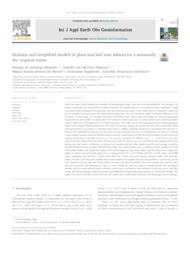Realistic and simplified models of plant and leaf area indices for a seasonally dry tropical forest.
Realistic and simplified models of plant and leaf area indices for a seasonally dry tropical forest.
Author(s): MIRANDA, R. de Q.; NÓBREGA, R. L. B.; MOURA, M. S. B. de; RAGHAVANE, S.; GALVÍNCIO, J. D.
Summary: Leaf Area Index (LAI) models that consider all phenological stages have not been developed for the Caatinga, the largest seasonally dry tropical forest in South America. LAI models that are currently used show moderate to high covariance when compared to in situ data, but they often lack accuracy in the whole spectra of possible values and do not consider the impact that the stems and branches have over LAI estimates, which is of great influence in the Caatinga. In this study, we develop and assess PAI (Plant Area Index) and LAI models by using ground-based measurements and satellite (Landsat) data. The objective of this study was to create and test new empirical models using a multi-year and multi-source of reflectance data. The study was based on measurements of photosynthetic photon flux density (PPFD) from above and below the canopy during the periods of 2011?2012 and 2016?2018. Through iterative processing, we obtained more than a million candidate models for estimating PAI and LAI. To clean up the small discrepancies in the extremes of each interpolated series, we smoothed out the dataset by fitting a logarithmic equation with the PAI data and the inverse contribution of WAI (Wood Area Index) to PAI, that is the portion of PAI that is actually LAI (LAIC). LAIC can be calculated as follows: LAIC = 1 (WAI/PAI)). We subtracted the WAI values from the PAI to develop our in situ LAI dataset that was used for further analysis. Our in situ dataset was also used as a reference to compare our models with four other models used for the Caatinga, as well as the MODIS-derived LAI products (MCD15A3H/A2H). Our main findings were as follows: (i) Six models use NDVI (Normalized Difference Vegetation Index), SAVI (Soil-Adjusted Vegetation Index) and EVI (Enhanced Vegetation Index) as input, and performed well, with r2 ranging from 0.77 to 0.79 (PAI) and 0.76 to 0.81 (LAI), and RMSE with a minimum of 0.41m2m?2 (PAI) and 0.40m2m?2 (LAI). The SAVI models showed values 20% and 32% (PAI), and 21% and 15% (LAI) smaller than those found for the models that use EVI and NDVI, respectively; (ii) the other models (ten) use only two bands, and in contrast to the first six models, these new models may abstract other physical processes and components, such as leaves etiolation and increasing protochlorophyll. The developed models used the near-infrared band, and they varied only in relation to the inclusion of the red, green, and blue bands. (iii) All previously published models and MODIS-LAI underperformed against our calibrated models. Our study was able to provide several PAI and LAI models that realistically represent the phenology of the Caatinga.
Publication year: 2020
Types of publication: Journal article
Unit: Embrapa Semi-arid Region
Observation
Some of Embrapa's publications are published as ePub files. To read them, use or download one of the following free software options to your computer or mobile device. Android: Google Play Books; IOS: iBooks; Windows and Linux: Calibre.
Access other publications
Access the Agricultural Research Database (BDPA) to consult Embrapa's full library collection and records.
Visit Embrapa Bookstore to purchase books and other publications sold by Embrapa.

